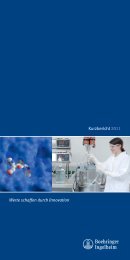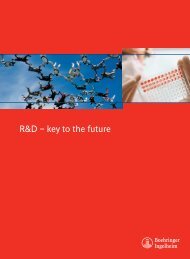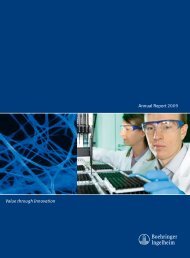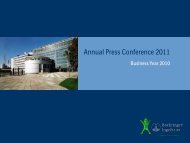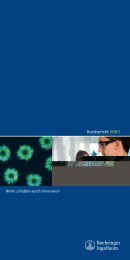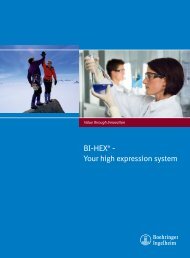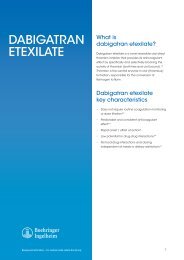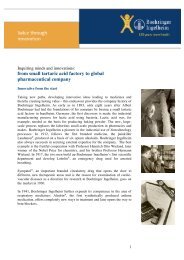RE-LY® StudY - Boehringer Ingelheim
RE-LY® StudY - Boehringer Ingelheim
RE-LY® StudY - Boehringer Ingelheim
Create successful ePaper yourself
Turn your PDF publications into a flip-book with our unique Google optimized e-Paper software.
<strong>RE</strong>-LY ® <strong>StudY</strong><br />
Randomized<br />
Evaluation of<br />
Long term<br />
anticoagulant<br />
therapY<br />
Background information – For medical media outside the US only<br />
SuMMARY<br />
• <strong>RE</strong>-LY ® is the largest atrial fibrillation (AF)<br />
outcomes study ever completed, enrolling<br />
18,113 patients in 44 countries1 • Results from <strong>RE</strong>-LY ® showed that in patients with<br />
AF, dabigatran etexilate 150mg significantly<br />
reduced the risk of stroke or systemic embolism<br />
by 34% compared to warfarin, with a 60%<br />
reduction in intracranial bleeding2 • Sub-group analysis showed that dabigatran<br />
etexilate provided similar benefits in AF patients<br />
who had suffered a prior stroke or transient<br />
ischaemic attack as compared to the overall AF<br />
population in <strong>RE</strong>-LY ® . 3 The benefits of dabigatran<br />
etexilate are consistent regardless of the<br />
patient’s risk profile for stroke. 4<br />
1
<strong>RE</strong>-LY ® study<br />
Study background<br />
Well-controlled vitamin K antagonist (VKA) therapy (warfarin) is highly effective in reducing the risk of stroke<br />
by 64% and the risk of death by 26%. 5 However, due to the limitations of VKAs, only 51% of eligible patients<br />
receive VKA therapy6 and fewer than half of these are controlled within the narrow therapeutic INR* range7 Therefore, there is an unmet medical need for an effective, safe and convenient oral anticoagulant without<br />
the limitations of VKA therapy.<br />
Primary objective of <strong>RE</strong>-LY ®<br />
To demonstrate that dabigatran etexilate is as effective and safe as well-controlled VKA therapy (warfarin)<br />
for the prevention of stroke and systemic embolism in patients with non-valvular AF.<br />
Study design<br />
<strong>RE</strong>-LY ® is the largest phase III stroke prevention in AF<br />
study ever completed, enrolling 18,113 patients in<br />
over 900 centres in 44 countries. 1<br />
• Average (median) treatment duration was 2<br />
years with a minimum 1 year follow-up<br />
• In contrast to other studies, <strong>RE</strong>-LY ® has involved<br />
equal numbers of anticoagulant experienced<br />
and naïve patients<br />
• The primary endpoint of the study was<br />
incidence of stroke (including haemorrhagic)<br />
and systemic embolism<br />
• Secondary outcome measures included all<br />
cause death, incidence of stroke (including<br />
haemorrhagic), systemic embolism, pulmonary<br />
embolism, acute myocardial infarction and<br />
vascular death (including death from bleeding).<br />
Inclusion criteria<br />
Background information – For medical media outside the US only<br />
<strong>RE</strong>-LY ® : study design<br />
Warfarin<br />
1 mg, 3 mg,<br />
5 mg<br />
(INR 2.0–3.0)<br />
n=6000<br />
AF with ≥1 risk factor<br />
Absence of<br />
contraindications*<br />
Dabigatran<br />
etexilate<br />
110 mg BID<br />
n=6000<br />
Dabigatran<br />
etexilate<br />
150 mg BID<br />
n=6000<br />
*Severe heart-valve disorder, stroke ≤14 days or severe stroke ≤6<br />
months before screening, increased haemorrhage risk, creatinine<br />
• Patients were eligible if they had AF documented clearance
<strong>RE</strong>-LY ® study<br />
Benefits of PROBE design<br />
(Prospective, randomized, open-label, blinded-endpoint)<br />
The key objective of a Phase III trial is to compare a new regimen with the existing standard under realistic<br />
clinical conditions. When the current standard therapy is complicated by the need for monitoring or dose<br />
adjustments, as in the case of VKA therapy, it is appropriate to use a PROBE design with corresponding<br />
controls.<br />
In <strong>RE</strong>-LY ® , the use of PROBE design, with stringent controls to minimise bias, is more likely to be representative<br />
of the true differences in the management of VKA and more reflective of how dabigatran etexilate will<br />
perform in daily practice.<br />
Although the study is un-blinded with respect to dabigatran etexilate or warfarin assignment:<br />
• outcomes are objective, clearly defined, and clinically relevant<br />
• evaluation of outcomes is blinded to all investigators, members of the Coordinating Center, the<br />
Operations Committee, the Steering Committee, the Event Adjudication Committee and <strong>Boehringer</strong><br />
<strong>Ingelheim</strong> as a sponsor<br />
• all primary and secondary outcomes were blindly and doubly adjudicated by the independent<br />
adjudication committee.<br />
<strong>RE</strong>-LY ® results<br />
Results from the landmark <strong>RE</strong>-LY ® study (Randomized Evaluation of Long term anticoagulant therapY) - the<br />
largest atrial fibrillation outcomes study ever completed (18,113 patients in 44 countries worldwide) - have<br />
demonstrated superior outcomes vs. warfarin for dabigatran etexilate for the prevention of stroke in patients<br />
with atrial fibrillation: 1,2<br />
Stroke/systemic embolism (%/yr)<br />
1.8<br />
1.5<br />
1.2<br />
0.9<br />
0.6<br />
RR 0.91 (95% CI: 0.74-1.11)<br />
p
<strong>RE</strong>-LY ® study<br />
150 mg dabigatran etexilate BId vs. warfarin:<br />
• provides superior stroke prevention - 34%<br />
reduced risk of stroke or systemic embolism2 • prevents three out of four AF related strokes2 – warfarin prevents 64% of strokes5 and<br />
dabigatran etexilate prevents an additional 34%<br />
of the remaining strokes or embolisms2 • superior reduction of intracranial bleeding – 60%<br />
reduced risk vs. warfarin2 • effective across all major patient sub-groups<br />
including age, gender, co-morbidities<br />
(symptomatic heart failure, hypertension,<br />
diabetes, prior stroke or transient ischaemic<br />
heart attack) and irrespective of stroke risk2,3,4 • reduced risk of total and life threatening<br />
bleeding (except for gastrointestinal bleeding).<br />
110 mg dabigatran etexilate BId vs. warfarin 2 :<br />
• Comparable rates of stroke/systemic embolism<br />
• Statistically significant reduction in haemorrhagic stroke<br />
• Statistically significant reduction in major bleeding rates<br />
Background information – For medical media outside the US only<br />
Major bleeding<br />
Major bleeding (%/yr)<br />
3.5<br />
3.0<br />
2.5<br />
2.0<br />
1.5<br />
1.0<br />
0.5<br />
0.0<br />
Events in:<br />
RR 0.80 (95% CI: 0.69-0.93)<br />
p
<strong>RE</strong>-LY ® study<br />
Sub-group analyses<br />
Sub-group analyses showed that the results of dabigatran etexilate were consistent with the overall results<br />
in patients with AF who had suffered prior stroke or transient ischaemic attack 3 and that the benefits were<br />
irrespective of a patient’s risk profile for stroke. 4<br />
CHADS 2<br />
score<br />
0-1<br />
2<br />
3-6<br />
D 110<br />
mg BID<br />
1.06<br />
1.43<br />
2.12<br />
BID = twice daily; D = dabigatran; P-values for<br />
interaction<br />
Oldgren J et al. ACC 2010; abstr 0903-04<br />
D 150<br />
mg BID Warfarin<br />
0.65<br />
0.84<br />
1.88<br />
1.05<br />
1.38<br />
2.68<br />
Benefits in patients with previous stroke:<br />
• This sub-group analysis from <strong>RE</strong>-LY ® ,included 3,623 AF patients with previous stroke or TIA and<br />
demonstrated that dabigatran etexilate provides major advantages over warfarin. 3<br />
• It showed numerically lower numbers of strokes and systemic embolism with dabigatran etexilate<br />
150mg bid compared to well-controlled warfarin. 3<br />
• In alignment with the results of <strong>RE</strong>-LY ® , dabigatran etexilate 110mg bid was shown to be non-inferior to<br />
warfarin with a significant reduction in major haemorrhage. Both doses provided significant reduction<br />
in haemorrhagic strokes and intracranial bleeds. 3<br />
Benefits in patients irrespective of a patient’s risk profile for stroke<br />
• In this sub-group analysis the efficacy and safety of dabigatran etexilate and warfarin was evaluated<br />
across low, medium and high stroke risk groups, classified according to CHADS score.*<br />
2<br />
• Dabigatran etexilate 150mg bid reduced the number of strokes in patients with AF when compared to<br />
well-controlled warfarin, irrespective of a patient’s risk profile for stroke4 • Dabigatran etexilate 150mg bid and dabigatran etexilate 110mg bid were both associated with lower<br />
major bleeding rates when compared with well-controlled warfarin in patients with AF at low risk of stroke4 • Both doses of dabigatran etexilate provided significant reductions in intracranial bleedings vs. warfarin<br />
irrespective of a patients risk of stroke. 4<br />
Background information – For medical media outside the US only<br />
Dabigatran 110 mg BID<br />
vs. warfarin<br />
Low<br />
Risk<br />
Medium<br />
Risk<br />
High<br />
Risk<br />
Dabigatran<br />
better<br />
P=0.44<br />
0 0.5 1.0 1.5 2.0<br />
Warfarin<br />
better<br />
Low<br />
Risk<br />
Dabigatran 150 mg BID<br />
vs. warfarin<br />
Medium<br />
Risk<br />
High<br />
Risk<br />
Dabigatran<br />
better<br />
P=0.82<br />
0 0.5 1.0 1.5 2.0<br />
CHADS score is a simple index that is widely used to assess the risk of stroke of a patient with<br />
2<br />
atrial fibrillation. It can be used to guide antithrombotic therapy.The name CHADS comes from the<br />
2<br />
components included in the index: Congestive Heart Failure history (1 point), Hypertension history<br />
(1 point), Age ≥ 75 years (1 point), Diabetes mellitus history (1 point), Stroke or TIA history (2 points).<br />
Fuster V, et al. Circulation 2006; 114:e257-e354<br />
Warfarin<br />
better<br />
5
<strong>RE</strong>-LY ® study<br />
Implications of <strong>RE</strong>-LY ®<br />
For healthcare professionals and patients, dabigatran etexilate represents a very important advance in<br />
the prevention of stroke in patients with AF. The results from <strong>RE</strong>-LY ® demonstrate that dabigatran etexilate<br />
is as effective (110mg bid) or more effective (150mg bid) than warfarin in preventing stroke and systemic<br />
embolism and causes less cerebral bleeding, across all levels of stroke risk. In addition, a recent<br />
sub-group analysis has shown that dabigatran etexilate 150mg bid is the first treatment to reduce stroke<br />
in patients with atrial fibrillation at low, medium or high risk of stroke, providing effective stroke prevention<br />
across the full spectrum of stroke risk.<br />
The efficacy of dabigatran etexilate is independent of body weight, there are no food interactions, a low<br />
potential for drug-drug interactions, and patients do not have to see a physician regularly to monitor the<br />
coagulation system.<br />
disclaimer<br />
Dabigatran etexilate is not approved for clinical use in stroke prevention in atrial fibrillation prevention.This<br />
information is provided for medical education purposes only.<br />
References<br />
1. Ezekowitz MD, Connolly S, Parekh A, et al. Rationale and design of <strong>RE</strong>-LY: Randomized evaluation of long-term anticoagulant therapy, warfarin,<br />
compared with dabigatran. Am Heart J 2009;157: 805-10<br />
2. Connolly SJ, Ezekowitz MD, Yusuf S, et al. Dabigatran versus warfarin in patients with atrial fibrillation. N Engl J Med. 2009;361(12):1139–1151<br />
3. Diener HC. Dabigatran Compared to Warfarin in Patients with Atrial Fibrillation and Prior TIA or Stroke: Results of <strong>RE</strong>-LY. Presented at the International<br />
Stroke Conference, 26th February 2010.<br />
4. Oldgren J, et al. Dabigatran etexilate versus warfarin in atrial fibrillation patients with low, moderate and high CHADS2 score – a <strong>RE</strong>-LY ® subgroup<br />
analysis. Presented at the 59th Annual Scientific Session of the American College of Cardiology, 15th March 2010.<br />
5. Hart RG, Pearce LA, Aguilar MI, et al. Meta-Analysis: antithrombotic therapy to prevent stroke in patients who have non-valvular atrial fibrillation.<br />
Ann Intern Med 2007;146:857-67<br />
6. Hylek EM, D’Antonio J, Evans-Molina C, et al. Translating the results of randomized trials into clinical practice. The challenge of warfarin candidacy<br />
among hospitalized elderly patients with atrial fibrillation. Stroke 2006;37:1075-80<br />
7. Samsa GP, Matchar DB, Goldstein LB, et al. Quality of anticoagulation management among patients with atrial fibrillation: results of a review of<br />
medical records from 2 countries. Arch Intern Med 2000;160:967-73<br />
For more information, contact:<br />
dr Reinhard Malin<br />
<strong>Boehringer</strong> <strong>Ingelheim</strong> GmbH<br />
Phone: +49/6132/7790815<br />
Fax: +49/6132/77 66 01<br />
E-mail: press@boehringer-ingelheim.com<br />
Background information – For medical media outside the US only<br />
6



